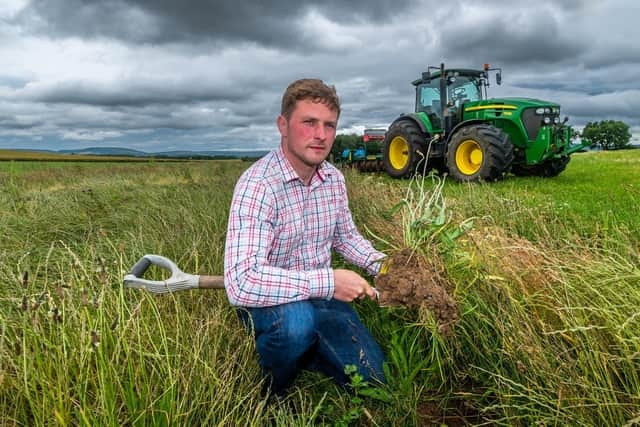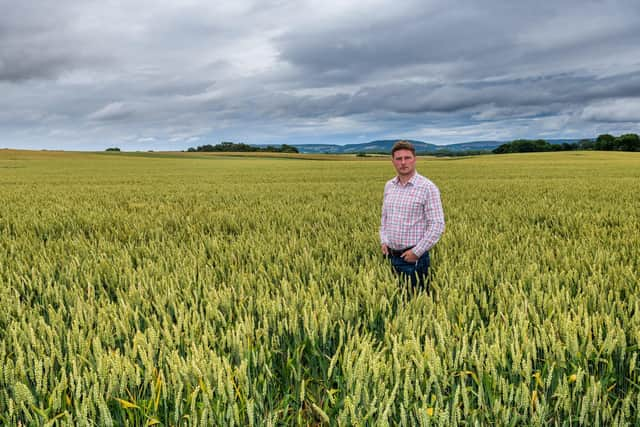Farm of the Week: American zero tillage techniques in North Yorkshire - and fertiliser costs up by 400% in a year
Around four years ago that opportunity came his way when he took on the 150-acre Manor Farm in Seamer, near Stokesley, owned by his grandmother Rita.
Matthew is the fifth generation at Manor Farm since his great-great-grandfather Howard Nichols purchased the farm in 1908. Matthew’s father, Michael, who passed away when he was 19, never got involved in the farm, but Matthew said that it was his grandad, Thomas Geoffrey, who had offered him the opportunity.
Advertisement
Hide AdAdvertisement
Hide Ad“When I was a kid I wrote down what I wanted to do if I ever had chance to farm. It was basically to have pigs and to undertake no tillage drilling. The reason I’d thought that way was I’d seen that they’d always gone for no tillage in America and growing up I had wondered why no one was doing it here.


“At some point I had asked my granddad about what would happen to the farm in the future and he’d said he would like me to take it on. I’ve built up my own businesses in agronomy, working as an independent consultant, and in contract spraying across 18,000 acres each year.
“Grandad had already semi-retired by then and he had been farming part of the farm and had been using contractors on the other half. When I had started my working life I had worked for them.
“We set up a new partnership with my grandad involved and started afresh. I had some of my own farm machinery already by this time because of the contracting business."


Advertisement
Hide AdAdvertisement
Hide AdMatthew said he’d had no hesitation in taking on the farm and that the combination of farming in his own right, contracting and agronomy gives him an interesting mix and one that works.
“I’d studied at Askham Bryan College once a week from 16 to 19, worked for Bainbridge’s, the local agricultural contractor that worked the farm before me, and had then joined ProCam as an agronomist. I set up independently when I was 23. I qualified for my BASIS and FACTS spraying qualifications in my early twenties.
“When I took on the farm I decided that I wanted to go down the whole regenerative agriculture route because if I’d gone down the intensive route I would have needed a lot more machinery and tackle and that would have led to more cost; and because regenerative agriculture is about leaving the land in a better state.
“You’re looking at soil health, carbon levels, organic matter and nutrient levels. When you’re starting from scratch and looking at the cost of things it just makes sense to do it this way.
Advertisement
Hide AdAdvertisement
Hide AdMatthew said he has opted for zero tillage to improve his soil and to make the growing of crops more affordable.
“I use zero tilling to help the soil and because it is cheaper than traditional commercial arable farming, but the benefits are also that you look at longer term crop rotation, greater varieties of crops and look away from standard cropping.
“I have predominantly arable land but I’m trying herbal leys and legume mixtures to help the rotation. I have stock on the land through other farmers grazing in winter but in the long term I’d like to graze the herbal leys throughout the year and have my own livestock.
“My rotation varies but is largely cereal crop, break crop, cereal crop, break crop. Some of these break crops are winter breaks and some are spring. When you go this way you’ve got to be willing and receptive to changes in rotation and not just look at the short term.
Advertisement
Hide AdAdvertisement
Hide Ad“I think the main driver of regenerative farming just at the moment is that input costs are absolutely out of control. Machinery costs have risen 80 per cent since 2008 and fertiliser costs 400 per cent more than last year. Everything has just gone crackers."
Matthew’s current cropping is winter wheat, oilseed rape, linseed, beans and herbal leys with around 40 to 50 per cent winter wheat. He has also introduced pigs to the farm on a bed and breakfast basis. It is a fulfilment of what he wanted to achieve as a child – pigs and arable cropping.
“We have 1,400 weaners arriving at four weeks old and around 7kg and going on from us nine weeks later,” Matthew said.
Matthew said that zero tillage makes sense.
“For me it is about how I can cover my acreage quicky and cheaply as much as it is also about reducing emissions, looking after the soil and improving food production.
Advertisement
Hide AdAdvertisement
Hide Ad“I am convinced that zero tillage works. I can now see more and more looking at going this way, but you’ve got to take the time to get it right. The first rule is don’t just go out and buy a fancy drill costing £90,000. You’ve got to get your head right, understand it, look at your rotation and why you want to do it.
“I have a Horsch 8-metre drill bought second-hand and converted it to the way I wanted through a really good farm company called JJ Metcalfe & Son at Newby Wiske. We’ve done trial work together. My coulters are 12mm wide offering low disturbance, moving as little soil as possible.
“I haven’t seen a drop in yield. We average around four tonnes per acre for winter wheat on fertile soil on silt loam to clay loam land. When you listen to soil scientists they tell you soil with a high silt content can be difficult to work because it doesn’t structure properly when dry, but the land here wets up well. The key to most farming is to have the drainage right."
Matthew said crop failures have not been down to regenerative measures but such as lateness of drilling and trying to go without slug pelleting.
Advertisement
Hide AdAdvertisement
Hide Ad“I left a crop of linseed a bit late for establishment and maybe should have stopped being so tight and slug pelleted. I’m on a learning curve. I’ve only been farming for four years. You live and learn from your mistakes.”
